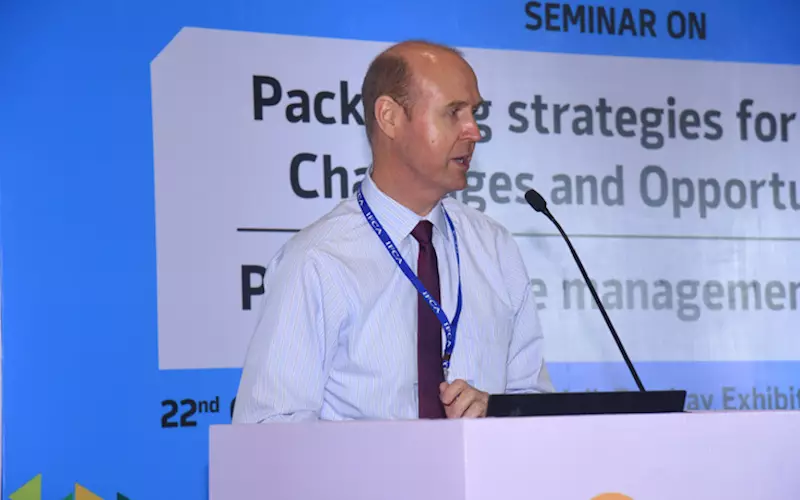Recycling technologies that add value to waste
India generates close to 410mt of plastic waste every year. At the IFCA conference, Kelvin Davies, Australian project manager at Nextek Technologies discussed the recycling problem in-depth. He presented strategies for ensuring that a recycled product has an upscale value, which is vital to achieve a circular economy
08 Nov 2019 | By WhatPackaging? Team
When you crunch the numbers you realise India is producing far more packaging than we are recycling. This is not an issue with India. It is a global issue and each geography has its own unique challenges. Recycling occupies the centrestage today in almost all packaging discussions. It is a problem presenting both a technical challenge as well as a commercial challenge. Kelvin Davies of Nextek Technologies feels that in order to make recycling economically viable, market should demand better quality of recycled materials. This, according to Davies presents a great opportunity.
Davies explained, "The consumer at the end of the supply chain does not know or have a choice about the packaging used for the products they end up buying. They see the adverse effects when packaging materials end up in landfills, rivers and oceans and become reluctant to use such products. This can cause a huge business impact for the brands. As the core component of the business relies on supplying packaging, the industry as a whole needs to make a concerted effort to engage all components of the supply chain down to the consumers to enable the recycling of packaging materials."
The critical issue is not that packaging needs to be recyclable but it needs to be recycled. Davies felt, "As an industry we are failing. Right now the balance isn’t right. We are producing a lot of materials and we are recycling very little."
He said, "In defense of packaging, the industry presents the problems of food waste and how packaging helps in preserving food. That's not enough. We need to address sustainability and circular economy. For this, we need to engage the supply chain to get these materials back and make sure they are actually recycled."
Trends in recycling
Historically, recycling has been defined as taking a low value material and then with a low investment, processing it and monetising it at a higher value. Davies suggested a different approach will be required.
One of the strategies employed for collection is a container deposit scheme where a price is attached to the packaging. This price can be claimed once it is deposited. This creates an incentive to collect the packaging which is otherwise discarded for its low value.
Flexible films present a challenge for recycling and steps can be taken to avoid problematic combinations of film structures. Each packaging component, be it, inks, adhesives, polymers can be chosen such that it facilitates recycling and reuse. Technologies are being developed for separating the flexible film structures. Separating flexible film structures can help recycling them for higher value applications or a circular economy.
PRISM Technology
The PRISM project is a marking and identification system developed by Nextek alongwith Brunel University, Tomra, CCL, Mirage Inks, Johnson Matthey, Enlightened Lamp Recycling (ELR) Cleantech Europe and WRAP. The project will target recovering high value materials from packaging that currently is difficult to sort and has low value or no end markets and end up as residues at material recovery facilities. It used lumiscentscent pigments to create invisibly coded labels that are detected by automatic sorting equipment. The luminescent materials needed for these labels which will be developed from non-rare earth based compounds as well as materials recovered from fluorescent lamp recycling.
Another technology developed for sorting and separation is labelling which deploys marking and identification. These can be used by automatic sorting machines to classify and sort the materials based on their type and what the usage is. For example, a label can communicate to a sorting machine: "I am a PET bottle and was used for food. Therefore I can be used for packaging food, again."
These labels can be manufactured with fluorescent pigment marks. These can be integrated into the packaging substrate to be read by the machines under UV light or they can be a digital code incorporated as part of the packaging design. The digital code can also help the consumer learn about the recycling information of the packaging by scanning the code. The fluorescent marking has advantages of being invisible under normal light. It is especially helpful in sorting black coloured plastics which present problems in automatic sorting machines.
Bioplastics and compostable plastics are solutions developed for the packaging waste problem. But we need to understand that even if these are compostable, these materials have an end of life requirement. The consumer needs to be directed through the right processes to get the proper outcome.
Nextek has been an active consultancy since 2004 with staff in the United Kingdom and Australia providing expertise in the design, optimisation, processing and recycling of plastics materials. They work on projects that “add value” to waste and recycled materials as well as providing detailed feasibility studies for new technologies.











 See All
See All